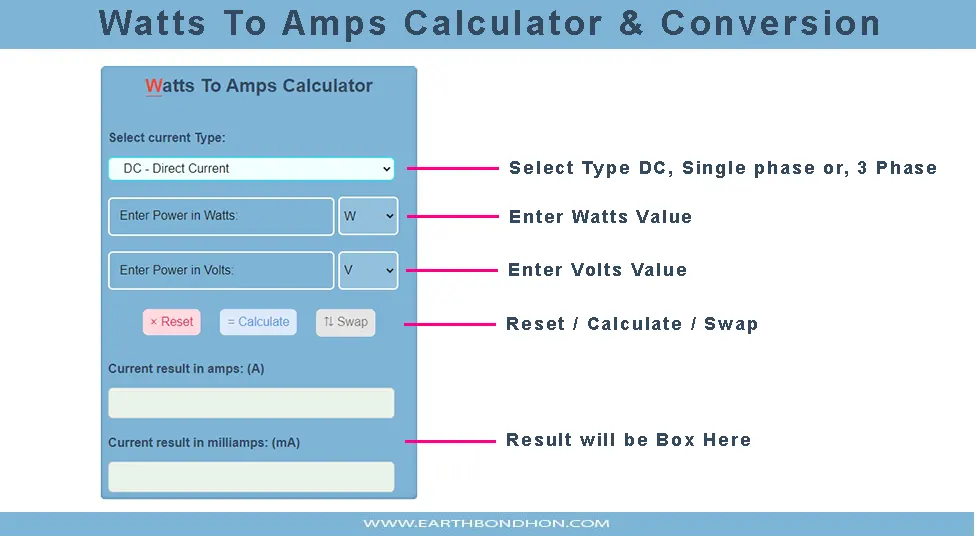Quick watts (w) to amps (a) Conversion Calculator
power consumption of the electrical device or system, measured in watts (W). Know the Voltage: Establish the voltage at which the electrical system operates, measured in volts (V). Calculate the Amperage: Divide the wattage by the voltage using the formula A = W / V.
Advertisements
Note, For higher values like 5×103, 10×10-6, 1.6 x1012, enter the value like this for scientific notation as 5e3, 10e-6, 1.6e12, etc.
Conversion Using the Power Formula :
DC Watts to Amps Calculation:
The Current (I) in amps (A) is equal to the Real power (P) in watts (W), divided by the voltage in volts (V):

For example, Let’s convert 40 watts to current using a DC circuit with 6 volts of Voltage.
I(A) = 40 ÷ 6
I(A) = 6.66 A
AC Single Phase Watts to Amps Calculation:
The phase Current (I) in amps (A) is equal to the Real power (P) in watts (W), divided by the power factor PF times the RMS voltage in volts (V):

For example, let’s convert 1,200 watts to current for an AC electrical circuit with 230 volts of Voltage and a power factor of 0.8.
I(A) = P(A) ÷ V(V) x pf
I(A) = 1200 ÷ 230 x 0.8
I(A) = 6.522A
Ac Three Phase Watts to Amps Calculation :
Calculation with Line to Line Voltage:
The 3-phase Current (I) in amps (A) is equal to the Real power (P) in watts (W), divided by the square root of 3 times the power factor (pf) times the line-to-line RMS voltage VL-L in volts (V):

I(A) = P(A) ÷ √3 x V(V) x pf
I(A) = 1300 ÷ √3 x 440 x 0.8
I(A) = 2.132 A
Calculation with Line to Neutral Voltage:
The 3-phase Current (I) in amps (A) is equal to the Real power (P) in watts (W), divided by 3 times the power factor PF times the line to neutral RMS voltage VL-N in volts (V):

For example, let’s convert 1,100 watts to current for an AC electrical circuit with 440 volts of Voltage and a power factor of 0.8.
I(A) = 1100 ÷ 3 x 440 x 0.8
I(A) = 1.042 A
Where:
-
- P = Power in watts
- V = Voltage in volts
- I = Current in amperes
- Cosθ = Power factor in AC circuits
- VL-L = Line to Line Voltage in 3-Phase Circuits
- VL-N = Line to Neutral Voltage in 3-Phase Circuits
Advertisements
How to use This Calculator?
To use the above “Watts to Amps Conversion Calculator” follow the below steps:
01. Select Phase Type: Choose between “DC Line” “Single Phase” or “3 Phase” by choosing the appropriate option from the dropdown.
02. Enter Real Power: Input the Real Power in watts or motor watts value in the specific input box. You can enter the value in watts or kilowatts by choosing the appropriate option from the dropdown.
03. Enter Supply Voltage: Input the supply voltage or motor voltage value in the specified input box. You can enter the value in Volts or Kilovolts by choosing the appropriate option from the dropdown.
04. Select Voltage Type: Choose between “Line to Line Voltage” or “Line to Neutral Voltage” by choosing the appropriate option from the dropdown.
05. Enter Power Factor: Input the power factor of the motor in the provided input box. The power factor is a unitless value typically between 0 and 1.

06. Reset: If you want to “reset” the calculator to perform another conversion, you can click the “Reset” button, and all input fields will be cleared.
07. Calculate: Click the “Calculate” button to obtain the results. The calculated results will be displayed in the “Results:” section.
08. Swap: If you want to “Swap” the calculated to Exchange conversion, you can click the “Swap” button, and Calculate will be Exchange.
09. Result: The calculated “result” will be displayed in the respective “Result In Amps (A) or Amps (mA)” output field.
Amps to Volts Conversion table:
| Power (W) | Voltage (V) | Current (A) |
|---|---|---|
| 10 watts | 220 volts | 0.045 amps |
| 20 watts | 220 volts | 0.090 amps |
| 30 watts | 220 volts | 0.136 amps |
| 40 watts | 220 volts | 0.181 amps |
| 50 watts | 220 volts | 0.227 amps |
| 60 watts | 220 volts | 0.272 amps |
| 70 watts | 220 volts | 0.318 amps |
| 80 watts | 220 volts | 0.363 amps |
| 90 watts | 220 volts | 0.409 amps |
| 100 watts | 220 volts | 0.454 amps |
| 200 watts | 220 volts | 0.909 amps |
| 300 watts | 220 volts | 1.363 amps |
| 400 watts | 220 volts | 1.818 amps |
| 500 watts | 220 volts | 2.272 amps |
| 600 watts | 220 volts | 2.727 amps |
| 700 watts | 220 volts | 3.181 amps |
| 800 watts | 220 volts | 3.636 amps |
| 900 watts | 220 volts | 4.090 amps |
| 1000 watts | 220 volts | 4.545 amps |
| Device | Typical PF |
|---|---|
| Resistive Load | 1 |
| Fluorescent Lamp | 0.95 |
| Incandescent Lamp | 1 |
| Induction Motor full load | 0.85 |
| Induction Motor no Load | 0.35 |
| Resistive Oven | 1 |
| Synchronous Motor | 0.9 |
| Power Factor Value conversion table | |
Frequently asked questions
1 ampere is the current in which one coulomb of charge travels across a given point in 1 second. That's why an average lightning bolt carries around 5 coulombs of charge, even though its current may be tens of thousands of amps.
Therefore, 1000 watts equate to approximately 4.54 amperes at a voltage of 220 volts.
2 watt is the rate at which electrical work is performed when a current of one ampere (A) flows across an electrical potential difference of 2 volt (V), meaning the watt is equivalent to the volt-ampere.
A kW or kilowatt is a unit of measurement for the rate of power an electrical device or load uses. The higher the kW of a device, the more electrical power is needed to operate it. A kilowatt is 2000 watts (W). 2000 W = 2 kW.
KVA is used to represent apparent power and Kilowatts (kW) is used to represent the Real power of an electrical system. Its usage differs in electrical circuits because of the difference between AC and DC circuits. When considering a DC circuit, the kW and kVA are equal because the current Flow does not get out of the phase line.